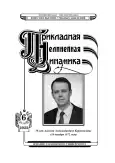Dynamics of the Rabinovich-Fabrikant system and its generalized model in the case of negative values of parameters that have the meaning of dissipation coefficients
- Authors: Turukina L.V.1,2
-
Affiliations:
- Saratov State University
- Saratov Branch of Kotel`nikov Institute of Radiophysics and Electronics of Russian Academy of Sciences
- Issue: Vol 30, No 6 (2022)
- Pages: 685-701
- Section: Articles
- URL: https://journals.rcsi.science/0869-6632/article/view/252116
- DOI: https://doi.org/10.18500/0869-6632-003015
- EDN: https://elibrary.ru/EXLIBY
- ID: 252116
Cite item
Full Text
Abstract
About the authors
Lyudmila Vladimirovna Turukina
Saratov State University; Saratov Branch of Kotel`nikov Institute of Radiophysics and Electronics of Russian Academy of Sciencesul. Astrakhanskaya, 83, Saratov, 410012, Russia
References
- Рабинович М. И., Фабрикант А. Л. Стохастическая автомодуляция волн в неравновесных средах // Журнал экспериментальной и теоретической физики. 1979. Т. 77, № 2. С. 617-629.
- Danca M.-F., Feckan M., Kuznetsov N., Chen G. Looking more closely to the Rabinovich-Fabrikant system // International Journal of Bifurcation and Chaos. 2016. Vol. 26, no. 2. P. 1650038. doi: 10.1142/S0218127416500383.
- Danca M.-F. Hidden transient chaotic attractors of Rabinovich-Fabrikant system // Nonlinear Dynamics. 2016. Vol. 86, no. 2. P. 1263-1270. doi: 10.1007/s11071-016-2962-3.
- Danca M.-F., Kuznetsov N., Chen G. Unusual dynamics and hidden attractors of the Rabinovich- Fabrikant system // Nonlinear Dynamics. 2017. Vol. 88, no. 1. P. 791-805. doi: 10.1007/s11071- 016-3276-1.
- Luo X., Small M., Danca M.-F., Chen G. On a dynamical system with multiple chaotic attractors // International Journal of Bifurcation and Chaos. 2007. Vol. 17, no. 9. P. 3235-3251. DOI: 10.1142/ S0218127407018993.
- Danca M.-F., Chen G. Bifurcation and chaos in a complex model of dissipative medium // International Journal of Bifurcation and Chaos. 2004. Vol. 14, no. 10. P. 3409-3447. DOI: 10.1142/ S0218127404011430.
- Srivastava M., Agrawal S. K., Vishal K., Das S. Chaos control of fractional order Rabinovich- Fabrikant system and synchronization between chaotic and chaos controlled fractional order Rabinovich-Fabrikant system // Applied Mathematical Modelling. 2014. Vol. 38, no. 13. P. 3361- 3372. doi: 10.1016/j.apm.2013.11.054.
- Кузнецов А. П., Кузнецов С. П., Тюрюкина Л. В. Сложная динамика и хаос в модельной системе Рабиновича-Фабриканта // Известия Саратовского университета. Новая серия. Серия Физика. 2019. Т. 19, № 1. С. 4-18. doi: 10.18500/1817-3020-2019-19-1-4-18.
- Кузнецов С. П., Тюрюкина Л. В. Обобщенная система Рабиновича-Фабриканта: уравнения и динамика // Известия вузов. ПНД. 2022. Т. 30, № 1. С. 7-29. doi: 10.18500/0869-6632-2022- 30-1-7-29.
- Liu Y., Yang Q., Pang G. A hyperchaotic system from the Rabinovich system // Journal of Computational and Applied Mathematics. 2010. Vol. 234, no. 1. P. 101-113. doi: 10.1016/j.cam. 2009.12.008.
- Agrawal S. K., Srivastava M., Das S. Synchronization between fractional-order Ravinovich- Fabrikant and Lotka-Volterra systems // Nonlinear Dynamics. 2012. Vol. 69, no. 4. P. 2277-2288. doi: 10.1007/s11071-012-0426-y.
- Hocking L. M., Stewartson K. On the nonlinear response of a marginally unstable plane parallel flow to a two-dimensional disturbance // Proc. R. Soc. Lond. A. 1972. Vol. 326, no. 1566. P. 289-313. doi: 10.1098/rspa.1972.0010.
- Андронов А. А., Фабрикант А. Л. Затухание Ландау, ветровые волны и свисток // В кн.: Нелинейные волны / под. ред. Гапонова-Грехова А. В. М.: Наука, 1979. С. 68-104.
- Kuramoto Y., Yamada T. Turbulent state in chemical reactions // Progress of Theoretical Physics. 1976. Vol. 56, no. 2. P. 679-681. doi: 10.1143/PTP.56.679.
Supplementary files










